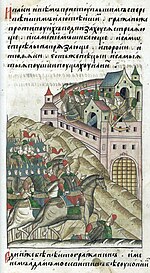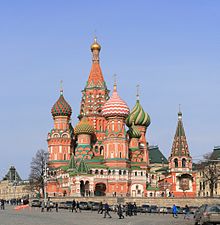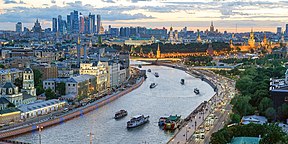
A | B | C | D | E | F | G | H | CH | I | J | K | L | M | N | O | P | Q | R | S | T | U | V | W | X | Y | Z | 0 | 1 | 2 | 3 | 4 | 5 | 6 | 7 | 8 | 9
This article may be too long to read and navigate comfortably. When this tag was added, its readable prose size was 15,546 words. (March 2024) |
Moscow
Москва | |
|---|---|
Red Square with the Spasskaya Tower (left), Saint Basil's Cathedral (right) and Ostankino Tower (background) View along the Moskva River with the Kremlin (right) and the Moscow International Business Center (left) | |
| Anthem: "My Moscow" | |
 | |
 | |
| Coordinates: 55°45′21″N 37°37′2″E / 55.75583°N 37.61722°E | |
| Country | |
| Federal district | Central |
| Economic region | Central |
| First mentioned | 1147[1] |
| Government | |
| • Body | City Duma[2] |
| • Mayor[3] | Sergey Sobyanin[3] |
| Area | |
| • Total | 2,561.5[4] km2 (989.0 sq mi) |
| • Urban | 6,154 km2 (2,376 sq mi) |
| • Moscow capital region | 48,360 km2 (18,670 sq mi) |
| Elevation | 156 m (512 ft) |
| Population | |
| • Total | |
| • Rank | 1st |
| • Density | 5,080/km2 (13,200/sq mi) |
| • Urban | |
| • Urban density | 2,762/km2 (7,150/sq mi) |
| • Metro | |
| • Metro density | 450/km2 (1,200/sq mi) |
| Demonym | Muscovite |
| GDP | |
| • Federal city | ₽24.471 trillion US$332 billion (2021) |
| • Per capita | ₽1,935,205 US$26,257 (2021) |
| Time zone | UTC+3 (MSK[10]) |
| ISO 3166 code | RU-MOW |
| Vehicle registration | 77, 177, 777; 97, 197, 797; 99, 199, 799, 977[11] |
| OKTMO ID | 45000000 |
| Website | mos.ru |
Moscow[a] is the capital and largest city of Russia. The city stands on the Moskva River in Central Russia, with a population estimated at 13.0 million residents within the city limits,[6] over 18.8 million residents in the urban area,[7] and over 21.5 million residents in the metropolitan area.[14] The city covers an area of 2,511 square kilometers (970 sq mi), while the urban area covers 5,891 square kilometers (2,275 sq mi),[7] and the metropolitan area covers over 26,000 square kilometers (10,000 sq mi).[14] Moscow is among the world's largest cities, being the most populous city in its entirety in Europe, the largest urban and metropolitan area in Europe,[7][14] and the largest city by land area on the European continent.[15]
First documented in 1147, Moscow grew to serve as the capital of the Grand Duchy of Moscow. When the Tsardom of Russia was proclaimed, Moscow remained the political and economic center for most of its history. Under the reign of Peter the Great, the Russian capital was moved to the newly founded city of Saint Petersburg in 1712, decreasing Moscow's influence. Following the Russian Revolution and the establishment of the Russian SFSR, the capital was moved back to Moscow in 1918, where it later became the political center of the Soviet Union.[16] In the aftermath of the dissolution of the Soviet Union, Moscow remained the capital city of the newly established Russian Federation.
The northernmost and coldest megacity in the world, Moscow is governed as a federal city,[17] where it serves as the political, economic, cultural, and scientific center of Russia and Eastern Europe. As an alpha world city,[18] Moscow has one of the world's largest urban economies.[19] The city is one of the fastest-growing tourist destinations in the world[20] and is one of Europe's most visited cities. Moscow is inhabited by the sixth-highest number of billionaires of any city in the world.[21] The Moscow International Business Center is one of the largest financial centers in Europe and the world and features the majority of Europe's tallest skyscrapers. Moscow was the host city of the 1980 Summer Olympics and one of the host cities of the 2018 FIFA World Cup.[22]
Moscow is the home of multiple Russian artists, scientists, and sports figures, along with museums, academic and political institutions, and theaters. The city contains several UNESCO World Heritage Sites and is known for its display of Russian architecture, particularly in areas such as the Red Square and buildings such as the Saint Basil's Cathedral and the Moscow Kremlin, the latter of which is the seat of power of the Government of Russia. Moscow is home to Russian companies in different industries and is served by a comprehensive transit network, which includes four international airports, ten railway terminals, a tram system, a monorail system, and the Moscow Metro, which is the busiest metro system in Europe and one of the largest rapid transit systems in the world. The city has over 40 percent of its territory covered by greenery, making it one of the greenest cities in the world.[15][23]
Etymology
The name of the city is thought to be derived from the name of the Moskva River.[24][25] Several theories of the origin of the name of the river have been proposed.
The most linguistically well-grounded and widely accepted is from the Proto-Balto-Slavic root *mŭzg-/muzg- from the Proto-Indo-European *meu- "wet",[25][26][27] so the name Moskva might signify a river at a wetland or a marsh.[24] Its cognates include Russian: музга, muzga "pool, puddle", Lithuanian: mazgoti and Latvian: mazgāt "to wash", Sanskrit: májjati "to drown", Latin: mergō "to dip, immerse".[24][26] In many Slavic countries Moskov is a surname, most common in Russia, Bulgaria, Ukraine and North Macedonia.[28] Additionally, there are similarly named places in Poland like Mozgawa.[24][25][26]
According to one the Finno-Ugric hypotheses, the Merya and Muroma people, who were among the several pre-Slavic tribes which originally inhabited the area, called the river Mustajoki "Black river", and the name of the river derives from this term.[29] Various other theories (of Celtic, Iranian, Caucasic origins), having little or no scientific ground, are now largely rejected by contemporary linguists.[24][25]
The original Old Russian form of the name is reconstructed as *Москы, *Mosky,[24][25] hence it was one of a few Slavic ū-stem nouns. As with other nouns of that declension, it had been undergoing a morphological transformation at the early stage of the development of the language, as a result, the first written mentions in the 12th century were Московь, Moskovĭ (accusative case), Москви, Moskvi (locative case), Москвe/Москвѣ, Moskve/Moskvě (genitive case).[24][25] From the latter forms came to the modern Russian name Москва, Moskva, which is a result of morphological generalization with the numerous Slavic ā-stem nouns.
However, the form Moskovĭ has left some traces in many other languages, including English: Moscow, German: Moskau, French: Moscou, Georgian: მოსკოვი, Latvian: Maskava, Bashkir: Мәскәү, Tatar: Mäskäw, Portuguese: Moscovo, Chuvash: Мускав, and Spanish: Moscú.
In a similar manner the Latin name Moscovia has been formed, later it became a colloquial name for Russia used in Western Europe in the 16th–17th centuries. From it as well came English Muscovy and muscovite.[30][failed verification]
Other names
Moscow has acquired several epithets, most referring to its size and preeminent status within the nation: The Third Rome (Третий Рим), the Whitestone One (Белокаменная), the First Throne (Первопрестольная), the Forty Soroks (Сорок Сороков) ("sorok" meaning both "forty, a great many" and "a district or parish" in Old Russian). Moscow is also one of the twelve Hero Cities. The demonym for a Moscow resident is "москвич" (moskvich) for male or "москвичка" (moskvichka) for female, rendered in English as Muscovite. The name "Moscow" is abbreviated "MSK" (МСК in Russian).[citation needed]
History
Prehistory
Archaeological digs show that the site of today's Moscow and the surrounding area have been inhabited since time immemorial. Among the earliest finds are relics of the Lyalovo culture, which experts assign to the Neolithic period, the last phase of the Stone Age.[31]
They confirm that the first inhabitants of the area were hunters and gatherers. Around 950 AD, two Slavic tribes, Vyatichi and Krivichi, settled here. Possibly the Vyatichi formed the core of Moscow's indigenous population.[32]
Early history (1147–1284)

The first known reference to Moscow dates from 1147 as a meeting place of Yuri Dolgoruky and Sviatoslav Olgovich. At the time it was a minor town on the western border of Vladimir-Suzdal Principality. The chronicle says, "Come, my brother, to Moskov" (Приди ко мне, брате, в Москов).[33]
In 1156, Knyaz Yuri Dolgorukiy fortified the town with a timber fence and a moat. In the course of the Mongol invasion of Kievan Rus', the Mongols under Batu Khan burned the city to the ground and killed its inhabitants.[citation needed]
The timber fort na Moskvě "on the Moscow River" was inherited by Daniel, the youngest son of Alexander Nevsky, in the 1260s, at the time considered the least valuable of his father's possessions. Daniel was still a child at the time, and the big fort was governed by tiuns (deputies), appointed by Daniel's paternal uncle, Yaroslav of Tver.[citation needed]
Daniel came of age in the 1270s and became involved in the power struggles of the principality with lasting success, siding with his brother Dmitry in his bid for the rule of Novgorod. From 1283 he acted as the ruler of an independent principality alongside Dmitry, who became Grand Duke of Vladimir. Daniel has been credited with founding the first Moscow monasteries, dedicated to the Lord's Epiphany and to Saint Daniel.[34]
Grand Duchy (1283–1547)

|

|

|
| The Moscow Kremlin in the late 16th century | The 1382 siege of Moscow | Red Square |
Daniel ruled Moscow as Grand Duke until 1303 and established it as a prosperous city that would eclipse its parent principality of Vladimir by the 1320s.
On the right bank of the Moskva River, at a distance of eight kilometres (5 mi) from the Kremlin, not later than in 1282, Daniel founded the first monastery with the wooden church of St. Daniel-Stylite, which is now the Danilov Monastery. Daniel died in 1303, at the age of 42. Before his death, he became a monk and, according to his will, was buried in the cemetery of the St. Daniel Monastery.
Moscow was quite stable and prosperous for many years and attracted a large number of refugees from across Russia. The Rurikids maintained large landholdings by practicing primogeniture, whereby all land was passed to the eldest sons, rather than dividing it up among all sons. By 1304, Yury of Moscow contested with Mikhail of Tver for the throne of the principality of Vladimir. Ivan I eventually defeated Tver to become the sole collector of taxes for the Mongol rulers, making Moscow the capital of Vladimir-Suzdal. By paying high tribute, Ivan won an important concession from the Khan.

While the Khan of the Golden Horde initially attempted to limit Moscow's influence, when the growth of the Grand Duchy of Lithuania began to threaten all of Russia, the Khan strengthened Moscow to counterbalance Lithuania, allowing it to become one of the most powerful cities in Russia. In 1380, prince Dmitry Donskoy of Moscow led a united Russian army to an important victory over the Mongols in the Battle of Kulikovo. Afterward, Moscow took the leading role in liberating Russia from Mongol domination. In 1480, Ivan III had finally broken the Russians free from Tatar control, and Moscow became the capital of an empire that would eventually encompass all of Russia and Siberia, and parts of many other lands.

In 1462 Ivan III, (1440–1505) became Grand Prince of Moscow (then part of the medieval Muscovy state). He began fighting the Tatars, enlarged the territory of Muscovy, and enriched his capital city. By 1500 it had a population of 100,000 and was one of the largest cities in the world. He conquered the far larger principality of Novgorod to the north, which had been allied to the hostile Lithuanians. Thus he enlarged the territory sevenfold, from 430,000 to 2,800,000 square kilometres (170,000 to 1,080,000 square miles). He took control of the ancient "Novgorod Chronicle" and made it a propaganda vehicle for his regime.[35][36]
The original Moscow Kremlin was built in the 14th century. It was reconstructed by Ivan, who in the 1480s invited architects from Renaissance Italy, such as Petrus Antonius Solarius, who designed the new Kremlin wall and its towers, and Marco Ruffo who designed the new palace for the prince. The Kremlin walls as they now appear are those designed by Solarius, completed in 1495. The Kremlin's Great Bell Tower was built in 1505–08 and augmented to its present height in 1600.
A trading settlement, or posad, grew up to the east of the Kremlin, in the area known as Zaradye (Зарядье). In the time of Ivan III, the Red Square, originally named the Hollow Field (Полое поле) appeared.
In 1508–1516, the Italian architect Aleviz Fryazin (Novy) arranged for the construction of a moat in front of the eastern wall, which would connect the Moskva and Neglinnaya and be filled in with water from Neglinnaya. This moat, known as the Alevizov moat and having a length of 541 metres (1,775 feet), width of 36 metres (118 feet), and a depth of 9.5 to 13 metres (31–43 feet) was lined with limestone and, in 1533, fenced on both sides with low, four-metre-thick (13-foot) cogged-brick walls.
Tsardom (1547–1721)

In the 16th and 17th centuries, the three circular defenses were built: Kitay-gorod (Китай-город), the White City (Белый город) and the Earthen City (Земляной город). However, in 1547, two fires destroyed much of the town, and in 1571 the Crimean Tatars captured Moscow, burning everything except the Kremlin.[37] The annals record that only 30,000 of 200,000 inhabitants survived.

The Crimean Tatars attacked again in 1591, but this time were held back by new defense walls, built between 1584 and 1591 by a craftsman named Fyodor Kon. In 1592, an outer earth rampart with 50 towers was erected around the city, including an area on the right bank of the Moscow River. As an outermost line of defense, a chain of strongly fortified monasteries was established beyond the ramparts to the south and east, principally the Novodevichy Convent and Donskoy, Danilov, Simonov, Novospasskiy, and Andronikov monasteries, most of which now house museums. From its ramparts, the city became poetically known as Bielokamennaya, the "White-Walled". The city's limits as marked by the ramparts built in 1592 are now marked by the Garden Ring.
Three square gates existed on the eastern side of the Kremlin wall, which in the 17th century, were known as Konstantino-Eleninsky, Spassky, Nikolsky (owing their names to the icons of Constantine and Helen, the Saviour and St. Nicholas that hung over them). The last two were directly opposite the Red Square, while the Konstantino-Elenensky gate was located behind Saint Basil's Cathedral.

The Russian famine of 1601–03 killed perhaps 100,000 in Moscow. From 1610 through 1612, troops of the Polish–Lithuanian Commonwealth occupied Moscow, as its ruler Sigismund III tried to take the Russian throne. In 1612, the people of Nizhny Novgorod and other Russian cities conducted by prince Dmitry Pozharsky and Kuzma Minin rose against the Polish occupants, besieged the Kremlin, and expelled them. In 1613, the Zemsky sobor elected Michael Romanov tsar, establishing the Romanov dynasty. The 17th century was rich in popular risings, such as the liberation of Moscow from the Polish–Lithuanian invaders (1612), the Salt Riot (1648), the Copper Riot (1662), and the Moscow Uprising of 1682.
During the first half of the 17th century, the population of Moscow doubled from roughly 100,000 to 200,000. It expanded beyond its ramparts in the later 17th century. It is estimated, that in the middle of the 17th century, 20% of Moscow suburb's inhabitants were from the Grand Duchy of Lithuania, practically all of them being driven from their homeland to Moscow by Muscovite invaders.[38] By 1682, there were 692 households established north of the ramparts, by Ukrainians and Belarusians abducted from their hometowns in the course of the Russo-Polish War (1654–1667). These new outskirts of the city came to be known as the Meshchanskaya sloboda, after Ruthenian meshchane "town people". The term meshchane (мещане) acquired pejorative connotations in 18th-century Russia and today means "petty bourgeois" or "narrow-minded philistine".[39]
The entire city of the late 17th century, including the slobodas that grew up outside the city ramparts, are contained within what is today Moscow's Central Administrative Okrug.
Numerous disasters befell the city. The plague epidemics ravaged Moscow in 1570–1571, 1592 and 1654–1656.[40] The plague killed upwards of 80% of the people in 1654–55. Fires burned out much of the wooden city in 1626 and 1648.[41] In 1712 Peter the Great moved his government to the newly built Saint Petersburg on the Baltic coast. Moscow ceased to be Russia's capital, except for a brief period from 1728 to 1732 under the influence of the Supreme Privy Council.
Empire (1721–1917)
Zdroj:https://en.wikipedia.org?pojem=МоскваText je dostupný za podmienok Creative Commons Attribution/Share-Alike License 3.0 Unported; prípadne za ďalších podmienok. Podrobnejšie informácie nájdete na stránke Podmienky použitia.
Antropológia
Aplikované vedy
Bibliometria
Dejiny vedy
Encyklopédie
Filozofia vedy
Forenzné vedy
Humanitné vedy
Knižničná veda
Kryogenika
Kryptológia
Kulturológia
Literárna veda
Medzidisciplinárne oblasti
Metódy kvantitatívnej analýzy
Metavedy
Metodika
Text je dostupný za podmienok Creative
Commons Attribution/Share-Alike License 3.0 Unported; prípadne za ďalších
podmienok.
Podrobnejšie informácie nájdete na stránke Podmienky
použitia.
www.astronomia.sk | www.biologia.sk | www.botanika.sk | www.dejiny.sk | www.economy.sk | www.elektrotechnika.sk | www.estetika.sk | www.farmakologia.sk | www.filozofia.sk | Fyzika | www.futurologia.sk | www.genetika.sk | www.chemia.sk | www.lingvistika.sk | www.politologia.sk | www.psychologia.sk | www.sexuologia.sk | www.sociologia.sk | www.veda.sk I www.zoologia.sk








